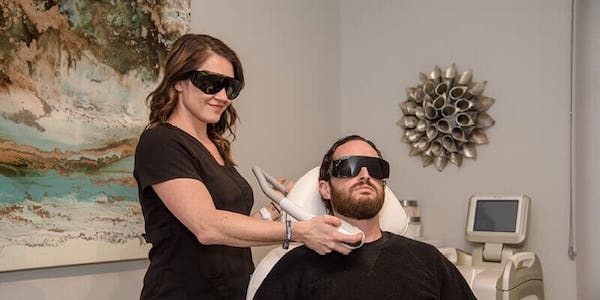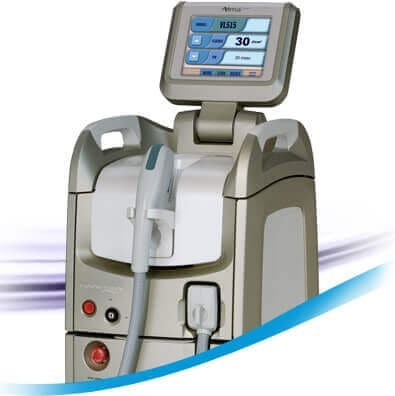
With summer coming to a close, patients often want to know what they can do to get rid of sun damage and improve their skin’s overall texture and tone. One of the most popular treatments is IPL therapy. In this post, I will answer many common questions about the treatment and provide some good tips for maximizing effectiveness and recovery.

What is IPL Therapy?
Intense Pulsed Light (IPL) therapy is a non-invasive and non-ablative treatment that uses high intensity pulses of visible broad-spectrum light. The light filters out unwanted wavelengths as a means of treating multiple skin conditions and abnormalities. IPL targets the lower layers of skin (dermis) without affecting the top layers of skin (epidermis) and addresses several skin conditions, including:
- Age spots, sun damage, freckles
- Broken capillaries, redness, hemangiomas
- Fine lines, wrinkles, overall pore size
IPL therapy can be performed on various areas of the skin, including the face, neck, chest, arms and hands. Its advantage, versus ablative resurfacing treatments, is that there is minimal downtime.
Who is a Good Candidate for IPL Therapy?
As a Nurse Practitioner, I properly ensure each patient is a good candidate for the treatment during the initial consultation and that their desired results are likely achievable with each treatment.
You may not be a good candidate for IPL therapy if you have the following skin/medical conditions:
- Melasma
- Prone to hyper/hypopigmentation
- Have a history of keloids
- Pregnant or breastfeeding
If patients are taking or using any photosensitizing medications such as retinols or hydroquinone, we advise to stop 3-5 days prior to IPL therapy. Patients with a history of cold sores should let their practitioners know prior to scheduling treatment.
What Does the IPL Therapy Procedure Involve?
Throughout the treatment session, patients and practitioners wear protective eyewear. The smooth, glass surface of the IPL treatment head is applied to the skin, delivering precise pulses of light to the area being treated. IPL treatments are relatively painless compared to other facial rejuvenation techniques. Topical anesthetics are not usually necessary because many IPL devices have an integrated cooling system. Cool ultrasound gel is also applied to the treatment areas, which reduces discomfort. The sensation has been described as a hot snap of a rubber band or pinch.
Most patients can return to work immediately after treatment and makeup may be applied right away. Treatment sessions usually last about 20 minutes. A course of 3 sessions every 4-8 weeks may be needed to achieve desired results. Single session treatments are done every 6-12 months for maintenance.
Combination IPL Therapy
IPL therapy may be combined with other treatments to maximize results. Microneedling can have very dramatic results when combined with IPL. The two procedures both stimulate collagen production and therefore will work synergistically to improve texture, tone and fine lines. Additionally, Dermasweep can be performed 2 weeks after IPL therapy to aid in the exfoliation process.
Side-Effects & Aftercare
Treatment side effects are minor and include:
- Pain/discomfort during treatment (reduced by cooling measures).
- Skin may become pink or red immediately after the procedure.
- Sensation of a mild sunburn (redness, peeling, swelling) that may last a few days after treatment.
- Sun spots and discoloration may appear darker and more prominent after treatment. They will often have a “coffee ground” appearance. This is normal and a good sign that the treatment is working. These will naturally flake off 3-14 days after treatment.
- Rarely, skin pigment may absorb too much light energy and blistering can occur.
- Sometimes the pigment cells (melanocytes) can be damaged leaving darker or paler patches of skin. White patches or scars are rarely permanent.
- Hair loss may occur in treatment areas.
- Rarely, bruising may occur at treatment sites.
Treatment Aftercare is as follows:
- Avoid unprotected sun exposure after your IPL treatment. The skin is especially sensitive as it heals and re-damaging the skin is possible during this time.
- Avoid saunas and hot steam for at least 48 hours.
- Avoid strenuous activity or exercise that would heat up the skin for 48 hours after treatment. Overheating the skin can reduce the positive effects of the treatment.
- Do not scratch or pick the skin during recovery. Do not use exfoliative devices such as a Clarisonic brush until all scabs have flaked off naturally.
- Avoid any product or supplement high in Vitamin A, such as retinoic acid, glycolic acid, tretinoin (Retin-A), Accutane and alpha-hydroxy acids.
IPL therapy is a time-tested safe and effective treatment. While being relatively non-invasive, IPL can achieve dramatic results over a course of proper treatment and patient experience is typically very positive. A good treatment provider can use IPL therapy in a number of ways to provide patients with improved skin health an appearance. Ask about it in your next consultation!

